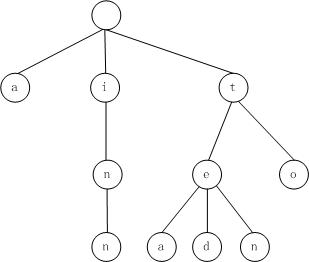字典树(Trie树)
来源:互联网 发布:秦美人十一阶坐骑数据 编辑:程序博客网 时间:2024/05/04 14:31
1. trie基础
(1) 是什么?
Trie,又称单词查找树或键树,是一种树形结构,是一种哈希树的变种。
(2) 性质
- 根节点不包含字符,除根节点外每一个节点都只包含一个字符
- 从根节点到某一节点,路径上经过的字符连接起来,为该节点对应的字符串
- 每个节点的所有子节点包含的字符都不相同
例如,单词序列a, to, tea, ted, ten, i, in, inn,对应的trie。

(3) 应用
用于统计和排序大量的字符串,但不仅限于字符串,所以经常被搜索引擎系统用于文本词频统计。
(4) 优点
- 最大限度地减少无谓的字符串比较
- 查询效率比哈希表高
2. 一个例子
- #include <stdio.h>
- #include <string.h>
- #include <stdlib.h>
- #define MAX 256//ascii码有256个字符,故每棵树的子节点最多有256个
- #define MAXLEN 256//单词最长为256
- typedef struct TrieNode
- {
- int count;
- struct TrieNode *next[MAX];
- }TrieNode;
- //插入一个单词
- void Insert(char *word,TrieNode *root)
- {
- int i;
- TrieNode *cur;
- if(word[0]=='\0')
- return;
- cur=root;
- for(i=0;word[i]!='\0';i++)
- {
- if(cur->next[word[i]]==NULL)
- {
- TrieNode *newNode = (TrieNode *)malloc(sizeof(TrieNode));
- memset(newNode,0,sizeof(TrieNode));
- cur->next[word[i]]=newNode;
- }
- cur=cur->next[word[i]];
- }
- cur->count++;
- return;
- }
- //创建树输入每个单词,以回车结束,则单词被插入树中,碰到*停止树的创建
- void Construct(TrieNode *&root)
- {
- char inStr[MAXLEN];
- int size=0;
- root = (TrieNode *)malloc(sizeof(TrieNode));
- memset(root,0,sizeof(TrieNode));
- while(1)
- {
- scanf("%s",inStr);
- if(strcmp(inStr,"*")==0)
- break;
- Insert(inStr,root);
- }
- return;
- }
- //遍历整棵树
- void Traverse(TrieNode *curP)
- {
- static char theWord[MAXLEN];
- static int pos=0;
- int i;
- if(curP==NULL)
- return;
- if(curP->count)
- {
- theWord[pos]='\0';
- printf("%s:%d\n",theWord,curP->count);
- }
- for(i=0;i<MAX;i++)
- {
- theWord[pos++]=i;
- //从这句话可以看出在递归调用子节点前,子节点的值已经加入到单词中了
- Traverse(curP->next[i]);
- pos--;
- }
- return;
- }
- //查找一个单词是不是在树中
- bool Find(TrieNode *root,char *word)
- {
- int i;
- TrieNode *cur;
- cur=root;
- for(i=0;word[i]!='\0';i++)
- {
- if(cur->next[word[i]]==NULL)
- {
- return false;
- }
- cur=cur->next[word[i]];
- }
- if(cur->count)
- return true;
- else
- return false;
- }
- int main()
- {
- TrieNode *root;
- char str[MAXLEN];
- Construct(root);
- printf("\n");
- Traverse(root);
- printf("\n");
- while(1)
- {
- scanf("%s",str);
- if(strcmp(str,"*")==0)
- break;
- printf("%s:%d\n",str,Find(root,str));
- }
- return 0;
- }
0 0
- 字典树(Trie)
- Trie(字典)树
- 字典树(Trie)
- 字典树(trie)
- 字典树(Trie)
- 字典树(trie)
- Trie(字典树)
- Trie(字典树)
- 字典树(Trie)
- 字典树(Trie)
- Codevs 4189 字典(字典树Trie)
- 字典树(trie树)
- Trie树(字典树)
- 字典树(Trie树)
- Trie树(字典树)
- 字典树(trie树)
- 字典树(Trie树)
- trie树(字典树)
- C程序编译过程浅析
- scikit-learn : 线性回归
- faster_rcnn c++版本的 caffe 封装,动态库(2)
- Codeforces Round #358 (Div. 2)-C. Alyona and the Tree(树形dp)
- RxJava
- 字典树(Trie树)
- 第十三周项目1(2)
- LeetCode-13 Roman to Integer
- 交通工具 虚函数的应用
- 阅读程序
- 编程语言 IDE 对比
- 动态获取view 大小以及 MeasureSpec介绍及使用详解
- 第十三周项目1(3)
- HTML5新增及移除的元素


